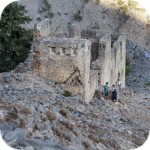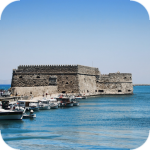

Agia Roumeli is the end point of the Samaria National Park route. Most people, after several kilometers of walking through the gorge, only dream of reaching the white buildings of the village, regenerating their strength and jumping into the sea. However, if, after passing Samaria, someone still has a lot of energy and enough time before the ferry leaves, we suggest entering the Turkish fortress located just above the village. To see its massive walls, just look up as you stroll through the streets of this village.

Gramvousa Island, or in fact Imeri Gramvousa (Ήμερη Γραμβούσα), is an inseparable point of a trip that combines a stay in the Balos Lagoon with visiting the remains of a fortress located on the top of Gramovousa. This is one of the most popular tourist trips in Crete.

Koules is a great example of Crete's multiculturalism. Located today in Greek hands, it was built by the Venetians, but is called a name taken from the Turkish language. Koules is derived from the words of Su Kulesi, which signify the Water Tower. Through the Venetians, this building was called the sea fortress - CastelloMare or RoccaMare.

Frangokastello is a small fortress that was built by the Venetians over four years from 1371. Initially, the castle was named after Saint Nikitas, but the local population, who did not like the Venetians, renamed the castle at Frangokastello, or the Franks Castle (a Catholic foreigner). The name was so good that in time the Venetians also treated it as officially in force.